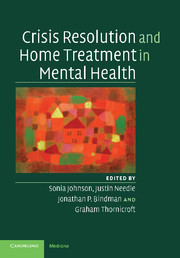Book contents
- Frontmatter
- Contents
- List of contributors
- Foreword
- Acknowledgements
- Section 1 Introduction and concepts
- Section 2 The evidence
- Section 3 Current practice
- 6 Crisis resolution teams: rationale and core model
- 7 The crisis resolution team within the community service system
- 8 Assessment of crises
- 9 Assessment and management of risk
- 10 Symptom management
- 11 Practical psychosocial interventions
- 12 Working with families and social networks
- 13 Strategies for promoting engagement and treatment adherence
- 14 Mixed blessings: service user experience of crisis teams
- 15 Early discharge and joint working between crisis teams and hospital services
- 16 Working with repeat users of crisis resolution services
- 17 Responding to diversity in home treatment
- 18 Coercion and compulsion in crisis resolution teams
- Section 4 Variations and enhancements
- Section 5 Developing a local service
- Index
- References
12 - Working with families and social networks
from Section 3 - Current practice
Published online by Cambridge University Press: 13 August 2009
- Frontmatter
- Contents
- List of contributors
- Foreword
- Acknowledgements
- Section 1 Introduction and concepts
- Section 2 The evidence
- Section 3 Current practice
- 6 Crisis resolution teams: rationale and core model
- 7 The crisis resolution team within the community service system
- 8 Assessment of crises
- 9 Assessment and management of risk
- 10 Symptom management
- 11 Practical psychosocial interventions
- 12 Working with families and social networks
- 13 Strategies for promoting engagement and treatment adherence
- 14 Mixed blessings: service user experience of crisis teams
- 15 Early discharge and joint working between crisis teams and hospital services
- 16 Working with repeat users of crisis resolution services
- 17 Responding to diversity in home treatment
- 18 Coercion and compulsion in crisis resolution teams
- Section 4 Variations and enhancements
- Section 5 Developing a local service
- Index
- References
Summary
In this chapter, we will use the term ‘social network’ to describe those people and groups with whom an individual has significant social contact. We will first examine the nature and importance of social networks, and will then go on to provide an account of what crisis resolution and home treatment teams (CRTs) can do to maximise the benefits to patients of support from key social relationships, both within the family and across their wider social networks.
The nature and importance of social networks
While for some the most important social relationships are within the family, for others they include a peer group, friends and acquaintances, neighbours or work colleagues. For most people there is a mix of all of these, varying perhaps with place of residence and state of health, and over time. Human beings are innately social in their behaviour, but it is important to remember that social relationships are not always supportive. For the mental health service user, relationships with and between informal and formal carers, and the relationships within the service between professionals and between the component teams, can have special importance (Chapter 7).
Bridgett and Polak (2003a) defined a social network as ‘a series of overlapping social systems: sets of human relationships that vary in size, formality, function and permanence’. At the less-intimate end of the social spectrum, there is an unclear boundary, with a more general social cohesiveness referred to as the social capital of a community.
- Type
- Chapter
- Information
- Crisis Resolution and Home Treatment in Mental Health , pp. 151 - 164Publisher: Cambridge University PressPrint publication year: 2008
References
- 4
- Cited by



